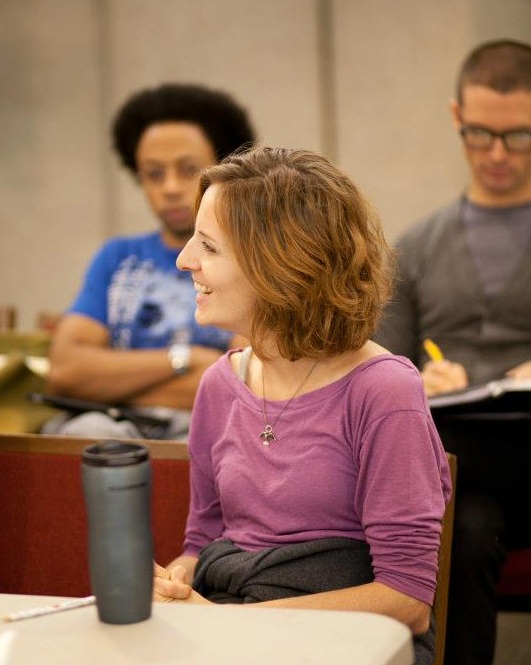Wilde Tales
(This post was originally published by The Public Theater.)
Over the past two years I’ve formed an illicit romance with Oscar Wilde. (Yes, my husband knows.) So, when Firebone Theatre decided to put together a festival of fairy tales, I immediately suggested Wilde’s The Selfish Giant. Wilde wrote his tales to be read aloud to children. This is, of course, in keeping with the oral story telling tradition. Much of the fairy tale’s form is determined by this parent/child oral exchange. As I began this adaptation only to discover that some of these formal elements contradict the traditional “rules” of modern playwriting.
The second challenge of adapting a fairy tale to the stage is that the fairy tale offers little in the way of human relationships. Most fairy tale heroes are isolated from the rest of humanity both geographically (a tower, a cell, a forest), and socially (fairy tale heroes
are usually either royalty or social outcasts). Wilde’s giant has no friends. Well, he has one, but he doesn’t live in the location of the story and Wilde says that they have little to say to each other. Wilde’s giant also isolates himself geographically by building a wall around his garden and home. When he finally comes in contact with other humans, their interaction is limited. The one character the giant enters into a relationship with remains distant for most of the story, and only draws close as the giant is about to die. This strange fairy tale form supports its meaning. Fairy tales concern themselves less with human relationships and more with divine ones. The fairy tale seeks to answer the question “how do I, a human, relate to my universe?”, rather than “how do I relate to my family or my lover?”. This is a common mis-interpretation of the princess fairy tales. Modern Americans often frown on the male/female relationship depicted in, say, Snow White, Sleeping Beauty, or Cinderella. Women are not meant to sit around waiting for a prince to rescue them, after all. But those stories are not about male/female love relationships. How could they be? There is no male/female relationship in them. The princess is on the journey alone. The prince only enters in the very end, and he rescues and loves her without her even knowing who he is. These are not stories of human romance, these are stories of the romance between mankind and its divine prince.
I’ve already spoken of the supernatural several times in the piece, perhaps to many of my readers’ discomfort. This element is a third challenge to the modern playwright. In the fairy tale, the supernatural is common place. Characters in the story do not react in surprise when animals talk or magical objects present themselves. The modern psyche wants to explain away the supernatural because we are uncomfortable with it. But the fairy tale won’t allow it. The boy at the end of Wilde’s The Selfish Giant bears the marks of Christ on his hands and feet. He is not a literal Christ, but he is clearly a divine being. During the time that the fairy tale form developed, most people believed in supernatural miracles. Today, even religious people deny the supernatural as a probable explanation for anything. But yet, the fairy tale cosmology attracts the hardest cynics, suggesting that perhaps beneath our surface disbelief lies a dormant wish for the divine.
Similar to it’s embrace of the supernatural, the fairy tale completely disregards of our modern sense of time. Time passes at lightning speed (Sleeping Beauty) or doesn’t pass at all. And there is little trace of its movements, one way or the other. Like Wilde’s manipulation of the effects of time in Dorian Gray, in the fairy tale, time serves to mark the development of man’s soul, rather than the circular travels of clock hands. Perhaps it is their disregard of time that has allowed fairy tales to persist through time, or rather, suspend themselves permanently outside of it.
Despite the challenges of adapting Fairy Tales to the stage, I believe that the fairy tale form showcases what theater does best: exploring the human soul. Many mothers discourage their children from allowing their imaginations to be swept up into the fairy tale universe, fearing that little girls who fantasize about becoming a princess will grow into spoiled brats. That may happen, but it will not be the fault of the fairy tale. The fairy tale hero (often a princess) “is cast into suffering and want, evidently destined to endure privation, misunderstanding, and malice, and yet summoned to a regal existence”.* Cinderella, perhaps the most popular fairy tale hero, bears the mark of the dead in her very identity (cinder=ash). The happiness and light in the fairy tale is found in the capacity for humans to change, “that the lowest can rise to the highest and even the highest can be destroyed”.* This is the stuff of great theater.
The fairy tale is not a form that most contemporary playwrights write in. It’s a unique, pre-Freudian art form that communicates a certain way of understanding human existence. When the form is broken, the meaning dissipates. Wilde preserved both. My hope is that, in my adaptation, I will accomplish the same. *Quotes from Max Luthi’s “Once Upon a Time, On the Nature of Fairy Tales.”
